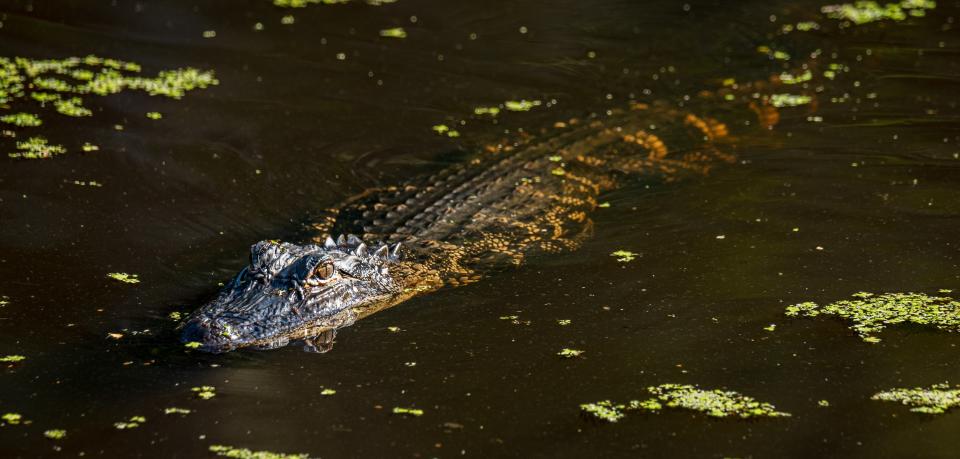Warmer weather means more outdoor fun and increase in wildlife sightings

Summer means warmer weather, more family outings and the possibility of a wildlife encounter, especially if area residents make their living spaces, perhaps inadvertently, more attractive to wild animals.
Georgia Department of Natural Resources Wildlife Resources Division biologist I.B. Parnell said a number of different wildlife species tend to make an appearance during this time of year.
“Most of the wildlife that people encounter is present all the time,” said Parnell. “We have a significant portion of migratory birds that come through our part of the world during the spring and summer. But the foxes, deer, squirrels, rabbits are considered resident wildlife, they’re here year round. We’re out working in our yards, so there’s a greater chance of us encountering wildlife because we are more active.”
Parnell said certain species of wildlife tend to be more active during this time of year because this is typically when they’re raising their young.
“A few animals in particular that you end up seeing more of in the summertime would be deer fawns,” said Parnell. "They’re born during this time of year. We may start to see them in April; however, we see them really in May and June. They tend to hide in people’s yards.”
Parnell said some folks see more wildlife because they leave attractants near their homes.

What is an attractant?
“An attractant is anything that would be attractive in terms of a food source,” said Parnell. “An attractant would differ depending on the species. For example, if you're attracting deer into your yard with corn, they're also going to be attracted to other things in your yard like your roses or daylilies. Don’t put corn in the yard if you don't want deer walking in and nibbling on other things.”
Parnell said there are other species of wildlife that may be attracted to your outdoor space.
“Leftover dog or cat food can attract foxes, raccoons and possums,” he said. “If you feed your pets outdoors during the summer months, a lot of times domestic animals will eat less because it’s hot. That leftover food has a smell. So possums, raccoons, foxes, coyotes, even bobcats sometimes, will smell that attractant and come up into the yard looking for an easy meal.”
More about attractants:
Common food attractants: trash and bird seed. It can attract raccoons, coyotes, foxes, bears, and rodents.
Common water attractants: pet water bowls, ponds and pools. Those can attract raccoons, coyotes, foxes, bears, and waterfowl.
Common shelter attractants: downed brush, leaf litter and pine straw. It can attract rodents and snakes.
“Feeding stray cats is another source that would be considered an attractant,” said Parnell. “The cat food is an attractant. The cats themselves are attractive to things like coyotes and Great Horned owls. Those are both wildlife that consider cats to be on their menu.”
If the attractant cannot be easily removed, experts recommend using an exclusion method to make it inaccessible to wildlife. For example, for deer grazing on landscaping place netting or fencing around the landscaping area.
What is Hazing?
“Hazing is any technique to make that wild animal know you don't want it in your yard,” said Parnell. “Some people use noisemakers. For instance, marbles or rocks in a tin can. They shake the can while yelling for the animal to ‘get out of here’ whenever they see an animal in the yard. You can also use commercial noisemakers, if that's legal where you live."
Additional examples of hazing include motion activated sprinklers or alarms and electric fencing.
Fewer places to roam
An increase in urbanization can cause a rise in wildlife activity, creating human and wildlife interactions which can be positive or negative, experts with the National Institutes of Health say.
Urbanization can lead to habitat loss, deforestation, and the encroachment of residential developments into wildlife habitats, according to experts with the National Wildlife Federation.
What can be done?
Parnell said funding is limited.
“We don’t have a state-funded wildlife removal program,” he said. “We don’t offer trapping services. If someone has an armadillo or raccoon in their yard, I can tell them what type of equipment to purchase, and they can remove it themselves if they want to. But if they catch that animal, they're responsible for disposal."

Hunter Young, wildlife biologist with the South Carolina Department of Natural Resources Division, said people tend to encounter white-tailed deer, racoons, black bears, alligators and snakes this time of year.
In the event you’ve attracted a bear to your property, Young offers a key tip.
“The bear is probably there because he's been attracted to something, for example unsecure trash or leftover pet food,” he said. “Remove the food source. Once you’ve removed the food source he may come back looking for it. Once he realizes it’s gone he’s not going to come back.”
For Georgia residents in need of any additional information, contact the Georgia Department of Natural Resources Wildlife Resources Division by visiting the website at www.georgiawildlife.com or call 706-595-4222.
For South Carolina residents in need of any additional information, contact the South Carolina Department of Natural Resources Wildlife Resources Division by visiting https://www.dnr.sc.gov/ or to reach the Law Enforcement and tips hotline call 1-800-922-5431.
This reporting content is supported by a partnership with several funders and Journalism Funding Funding Partners.
Erica Van Buren is the climate change reporter for The Augusta Chronicle, part of the USA TODAY Network. Connect with her at EVanBuren@gannett.com or on X: @EricaVanBuren32.
This article originally appeared on Augusta Chronicle: Urbanization could be cause of increase in wildlife activity

